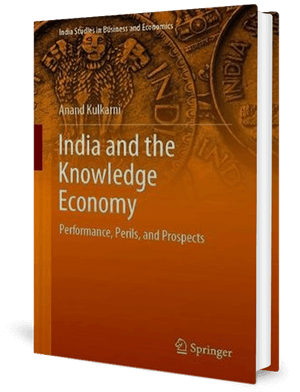India and the Knowledge Economy: Performance, Perils, and Prospects
Written by Anand Kulkarni and published by Springer, 2019.
Written by Anand Kulkarni and published by Springer, 2019.

Long time AAIR member, Anand Kulkarni, has written a book called India and the Knowledge Economy: Performance, Perils, and Prospects. Published by Springer in September 2019, the book will be officially launched on 28 November 2019.
Anand is Associate Director, Planning Performance and Risk at Victoria University in Melbourne. He is a higher education expert, with interests in the areas of industry development, research and innovation policy, international economic and social developments, Asian development, and climate change.
India and the Knowledge Economy: Performance, Perils, and Prospects contends that the knowledge economy, or one driven by new and improved ideas, innovation and know-how is, and will, drive economic and social prosperity, for both developed and developing nations, including India.
India is gaining attention for its growing importance on the world stage, driven by a burgeoning middle class, strong growth rates, growing internationalisation, and emerging innovation potential. A framework to think about knowledge has been developed, which draws on the premise that ideas originate anywhere, anytime by anyone, and unlocking the power of these ideas is key.
This framework is based on generic capability development and includes:
India’s performance on these parameters is benchmarked against 14 other countries, both developed and emerging, using a knowledge footprint concept and methodology. Knowledge footprint is the extent to which nations can develop, apply and diffuse knowledge at home and abroad.

The education chapter reiterates the pivotal role for higher education in the process and outcomes of knowledge discovery, development and diffusion to the wider economy and society. It examines in detail the performance of the higher education sector in India, canvassing issues of quality, governance, structure, linkages to the labour market, internationalisation, and the capacity to adapt to the challenges of the fourth industrial revolution and emerging skills needs. The chapter also considers whether India’s large tertiary age population has sufficient access to higher education. On a number of these matters, India faces very significant challenges, including raising general standards in institutions below the small elite tier of universities, strengthening regulatory arrangements and frameworks, fostering a stronger research culture in institutions, and developing a stronger interface between education and the labour market, as well as creating the capacity to cater to the growing cohort of tertiary eligible students.
The book develops a model for Indian higher education, recasting radically core institutional structures and efforts (teaching and research) around key missions or challenges confronting the nation, such as resource and environmental management supported by industry focussed institutions whose role is as a link between education and training, and industry and economic needs.
The book also canvasses a stronger role for overseas educational institutions in India to not only enhance capacity, but also foster the flow of ideas, know-how and capabilities, into and out of the country. There have been reforms of late in India, and this is acknowledged in the book, but there is still a long way to go.
Overall, the book takes the view that India’s economy needs institutional structures that would align it with being a powerhouse in the world of knowledge and ideas. These institutional changes include new bodies to promote collaboration, to unlock and leverage ideas and know-how from right across India and the globe, new mechanisms to foster participation of the citizenry in decision making, and revamped planning mechanisms that are inclusive and draw on locally based competitive advantages. These institutional changes need to be considered in the context of a changing role for Government, which puts a premium on facilitation, collaboration and networking amongst economic agents.
The importance of the need for new institutional architecture reflects the author’s view that institutions need to continually be renewed and regenerated to meet the rapidly changing needs of economy and society, especially in an era where knowledge, technology and skills will drive change. The author has held senior planning and research roles in higher education institutions in Australia, including think tanks, and has seen first-hand how institutions can and do need to evolve continuously.
Chapters can be purchased individually through Springer.
Subscribe to our Newsletter